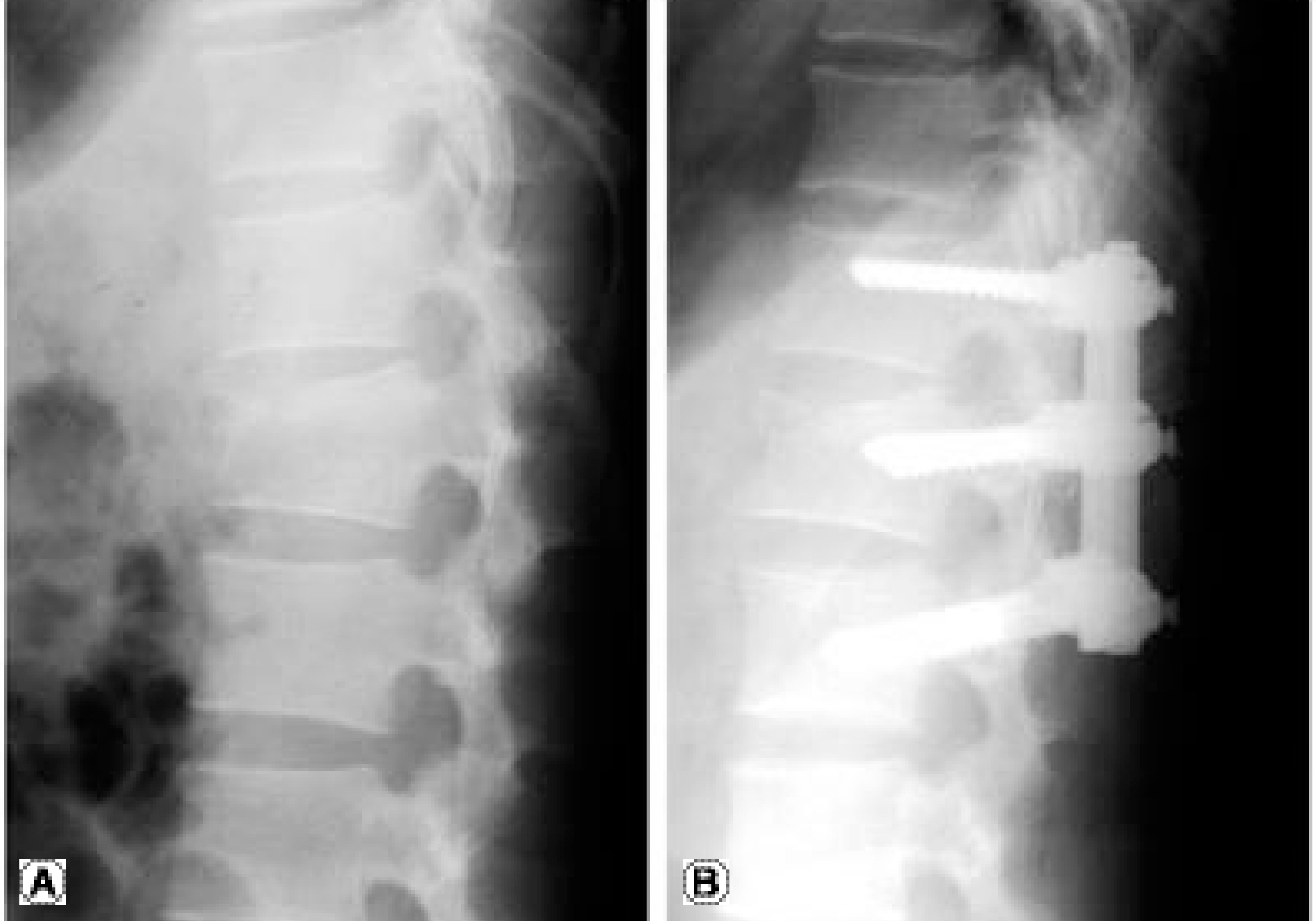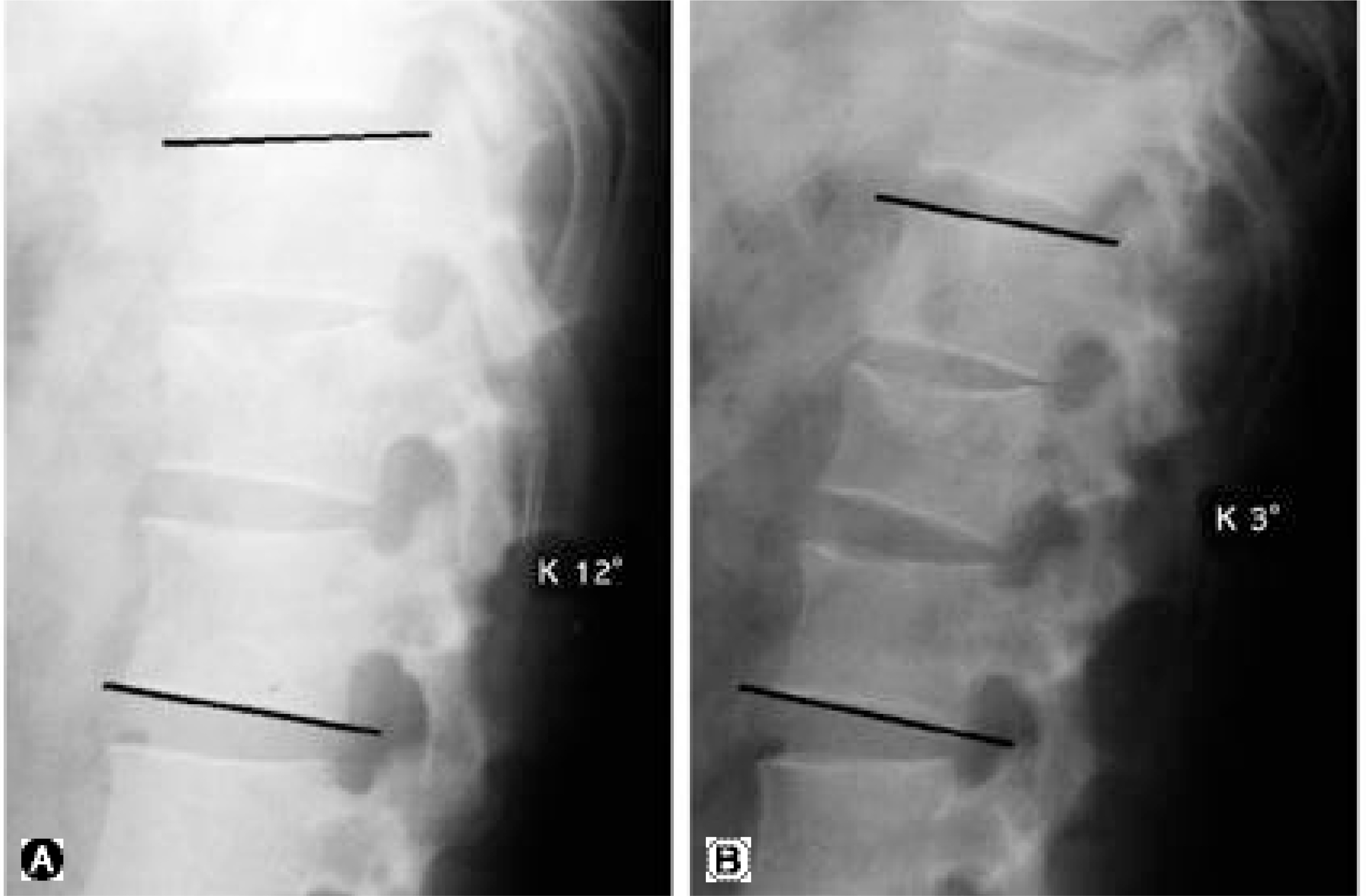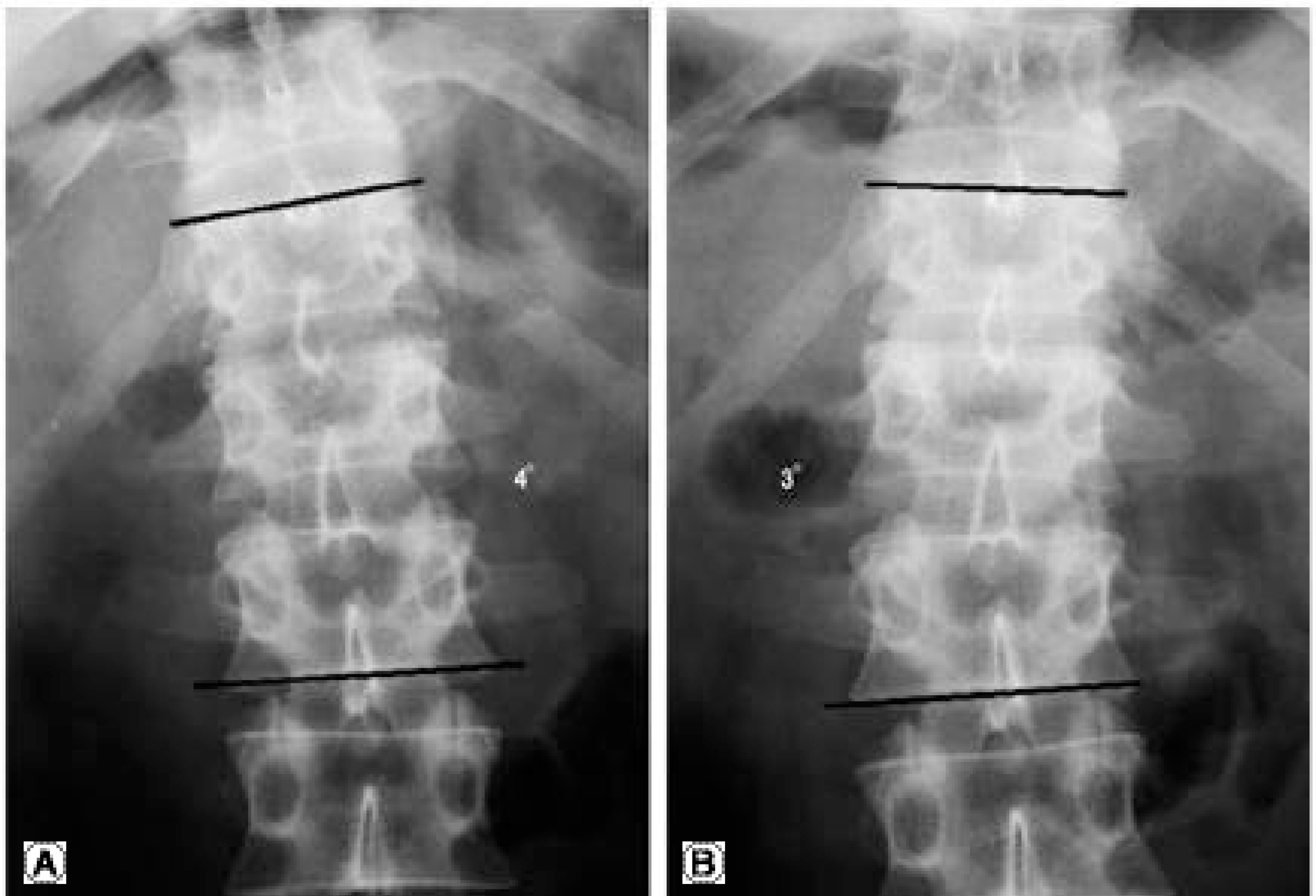Results of Non-fusion Method in Thoracolumbar and Lumbar Spinal Fractures
- Affiliations
-
- 1Department of Orthopedic Surgery, Chungbuk National University, Cheongju, Korea. kds@chungbuk.ac.kr
- KMID: 1583456
- DOI: http://doi.org/10.4184/jkss.2005.12.2.132
Abstract
- STUDY DESIGN: A retrospective study of surgically managed patients.
OBJECTIVES
To evaluate the results of posterior stabilization of a thoracolumbar fracture, without fusion, followed by the removal of metal implants within an appropriate period. Changes in the sagittal alignment and the restoration of segmental motion were also investigated. SUMMARY OF LITERATURE REVIEW: In managing unstable thoracolumbar and lumbar fractures, posterior fusion, using a transpedicular screw system, has been the treatment of choice, but results in the permanent loss of segmental motion.
MATERIALS AND METHODS
Twelve patients with thoracolumbar and lumbar spine fractures, under 40 years of age (mean 28.4 years), were managed using this non-fusion method. Implants were removed at mean 9.2 months after the initial fixation of the fracture. For metal-fixed segments, the sagittal alignment, such as the angle of kyphosis, height of body, recovered motion range in flexion-extension and right-left bending view, were measured radiologically and compared with a control group. Clinical aspects, such as gross deformity and functional ability, were also investigated.
RESULTS
The average sagittal angle at the time of injury was average 17.2 degrees, but became 1.7 degrees post-fixation, which increased after removal of the implants, reaching 9.8 degrees at the final follow up. The height of the fractured body was maintained until the final follow-up. The mean segmental motion measured in the sagittal and coronal planes were 11.7 and 9.5 degrees, respectively. Most patients were satisfied with the final gross appearance and functional outcomes. Only one patient showed considerable development of kyphotic angulation, but the functional outcome was good.
CONCLUSION
The author's non-fusion method seems to be effective in achieving stability and sagittal alignment, as well as in regaining segmental motion of the fixed segments. The non-fusion method seems to be an effective method for managing thoracolumbar fractures, especially for young active persons.
MeSH Terms
Figure
Cited by 3 articles
-
Multiple Non-contiguous Spine Fractures with Concomitant Injuries - A Case Report -
Soo Uk Chae, Yeung Jin Kim, Jung Hwan Yang, Ji Wan Lee, Jae In Park
J Korean Fract Soc. 2011;24(3):267-270. doi: 10.12671/jkfs.2011.24.3.267.Shape and Motion of Each Lumbar Segment in Normal Korean Adults
Dong-Soo Kim, Yong-Min Kim, Eui-Sung Choi, Hyun-Chul Shon, Kyung-Jin Park, Gee-Kang Park, Eun-Myung Lee, Hu-Shan Cui
J Korean Orthop Assoc. 2008;43(5):595-600. doi: 10.4055/jkoa.2008.43.5.595.The Effect of Vertebral Wedge Angle to the Change of Kyphotic Angle by the Posterior Instrumentation Method in Thoracolumbar Spine Fracture
Seok-Kon Kim, Myung-Ho Kim, Sung-Churl Lee, Sang-Hyuk Min, Jin-Won Lee
J Korean Soc Spine Surg. 2009;16(3):160-166. doi: 10.4184/jkss.2009.16.3.160.
Reference
-
1). Koh YD, Kim JO. Risk factors in progression of deformity in compression fracture of thoracolumbar junction. J Kor Soc Fracture. 1999; 12:372–378.
Article2). You JW, Lee SH, Park JK. Operative treatment of burst fracture on the thoracolumbar junction. J Kor Orthop Assoc. 1995; 30:364–374.3). Aebi M, Etter C, Kehl T, Thalgott J. Stabilization of the lower thoracic and lumbar spine with the internal spinal skeletal fixation system: indication, techniques and first results of treatment. Spine. 1987; 12:5454–551.4). Ahn JS, Lee JK, Hwang DS, Kim YM, Kim WJ, Byun KH. The change of kyphotic angle and anterior vertebral height after posterior or posterolateral fusion with transpedicular screw for thoracolumbar bursting fracture. J Kor Soc Fracture. 2003; 12:379–387.5). Knop C, Fabian HF, Bastian L, Blauth M. Late Results of Thoracolumbar Fractures After Posterior Instrumentation and Transpedicular Bone Grafting. Spine. 2001; 26:88–99.
Article6). Shin BJ, Kim DS, Choi CU. Analysis of loss of correction in spinal fractures treated by pedicle screw system. J Kor Spine Surg. 1994; 1:223–232.7). Oner FC, Van der Rijt RR, Ramos LM, Dhert WJ, Verbout AJ. Changes in the disc space after fractures of the thoracolumbar spine. J Bone Joint Surg. 1998; 80-B:833–839.
Article8). Lindsey RW, Dick W, Nunchuck S, Zach Z. R esidual intersegmental spinal mobility following limited pedicle fixation of thoracolumbar spine fractures with the fixateur interne. Spine. 1993; 15:474–478.9). Gardner VO, Amstrong GD. Long term lumbar facet joint change in spinal fracture patients treated with Har -rington rods. Spine. 1990; 15:479–484.10). Chen WJ, Niu CC, Chen LH, Chen JY, Shih CH, Chu LY. Back pain after thoracolumbar fracture treated with long instrumentation and short fusion. J Spinal Disord. 1995; 8:474–478.
Article
- Full Text Links
- Actions
-
Cited
- CITED
-
- Close
- Share
- Similar articles
-
- Treatment of Multiple Thoracolumbar and Lumbar Spine Fractures: Comparison of Contiguous and Non-Contiguous Fractures in Non-Osteoporotic Patients
- Clinical Features and Treatment Outcomes of Acute Multiple Thoracic and Lumbar Spinal Fractures: A Comparison of Continuous and Noncontinuous Fractures
- Posterior Spinal Fusion using Autogenous Bone Graft Combined with Xenograft for the Treatment of Thoracolumbar Spine Fractures
- Pelvic Bone Stress Fracture after Lumbar Spinal Fusion: Two Cases Report
- Lumbar Spinal Mobility after Anterior Stabilization of the Thoracolumbar Spinal Fractures




